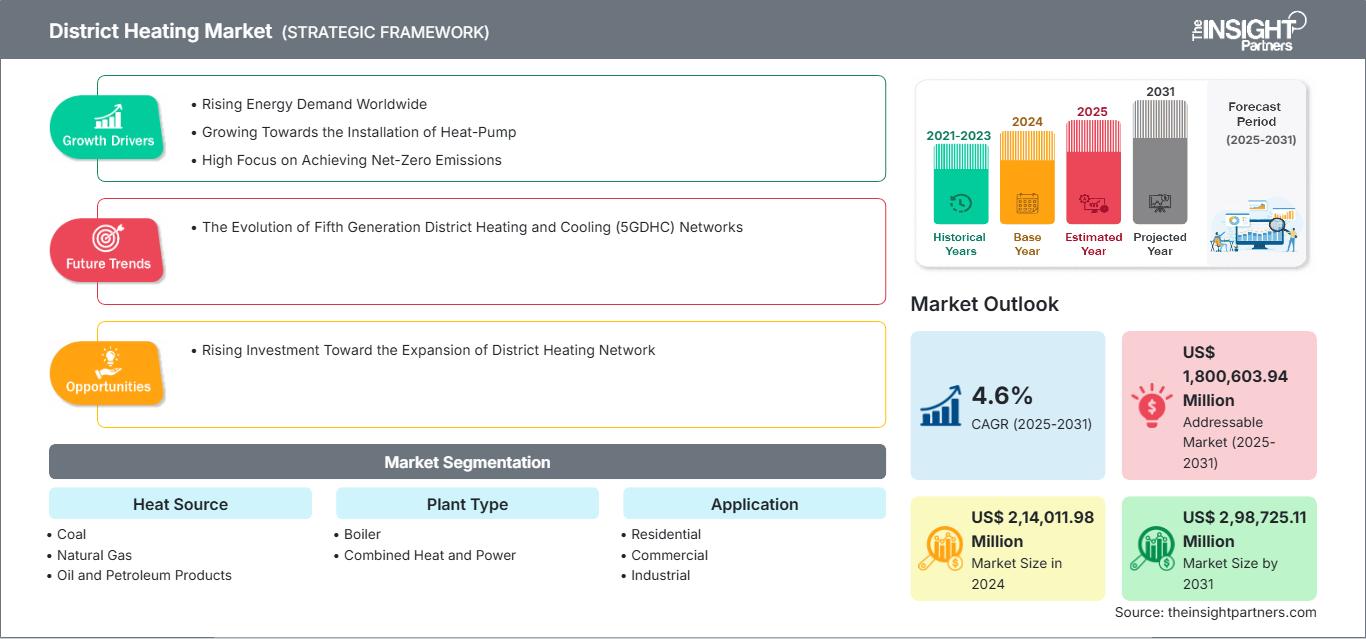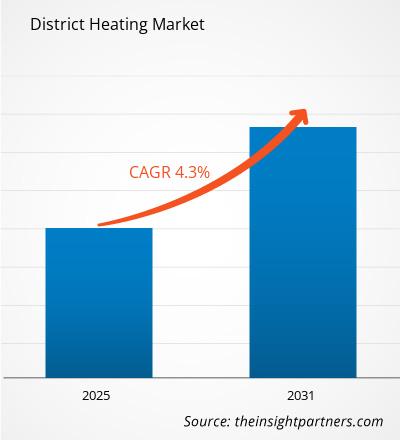The District Heating Market size is expected to reach US$ 2,98,725.11 million by 2031 from US$ 2,14,011.98 million in 2024. The market is estimated to register a CAGR of 4.6% during 2025–2031. The rising energy demand worldwide is likely to bring new trends to the market in the coming years.
District Heating Market Analysis
District heating is a water-based heating system that uses excess renewable energy from local sources such as biofuels, garbage, and industrial heat waste. It generates thermal energy from a central energy plant and distributes it to multiple buildings. This system supports energy plants to generate steam or hot water that is distributed 24/7 via well-insulated subsurface thermal piping networks. The thermal energy flows to the building's heating system, eliminating the need for boilers in individual buildings. District heating serves as a vital infrastructure by enhancing energy efficiency, reducing emissions, allowing flexibility in fuel supply, simplifying building operations and maintenance, and saving costs. It plays a significant role in transitioning to a more circular economy and reducing greenhouse gas emissions. District heating can free up capacity on the electric grid and is utilized as a renewable alternative to fossil fuels in buildings and industry, which increases its installation.
District Heating Market Overview
The rising energy demand, growing investment and installation of heat pumps, and high focus on achieving net zero drive the demand for district heating worldwide. The surging smart city projects across urban regions and the investment toward the expansion of district heating networks further fuel the market growth. The soaring research and development activities, the growing usage of waste heat from industrial processes, and the evolution of fifth-generation district heating and cooling (5GDHC) networks are expected to generate future growth opportunities in the market.
The district heating market is segmented on the basis of heat source, plant type, application, and geography. Based on heat source, the market is divided into coal, natural gas, oil and petroleum products, and others. In terms of plant type, the market is categorized into boiler, combined heat and power (CHP), and others. On the basis of application, the district heating market is categorized as residential, commercial, and industrial. By region, the district heating market is segmented into North America and Europe. Europe holds a larger share of the market, followed by Asia Pacific and North America. The district heating market in Europe is witnessing tremendous growth owing to the expansion of heating network, the rising smart city projects, the integration of advanced technologies such as IoT and 5G, favorable government initiatives, and funding for the development and expansion of district heating networks.
Customize This Report To Suit Your Requirement
You will get customization on any report - free of charge - including parts of this report, or country-level analysis, Excel Data pack, as well as avail great offers and discounts for start-ups & universities
District Heating Market: Strategic Insights

-
Get Top Key Market Trends of this report.This FREE sample will include data analysis, ranging from market trends to estimates and forecasts.
District Heating Market Drivers and Opportunities
Rising Energy Demand Worldwide
The district heating plants (such as boilers and combined heat and power) are used for central generation and delivery of heat (usually in the form of hot water or steam) to residential, commercial, and industrial buildings via an interconnected network of insulated pipes. According to International Energy Agency (IEA) data from March 2025, the demand for energy is soaring owing to the increasing electricity consumption and growing supply of renewables and natural gas. In 2024, global energy consumption increased by 2.2%, quicker than the average yearly demand increase of 1.3% between 2013 and 2023. In 2024, developing economies such as China (4,060 million tonnes (mtoe)), US (2,172 mtoe), India (1,135 mtoe), Russia (838 mtoe), Japan (391 mtoe), Brazil (336 mtoe), and other emerging economies accounted for more than 80% of global energy demand growth. Among these countries, China's energy consumption increased by approximately 3% in 2023. The scalability of district heating solutions makes them a popular choice in highly populated urban areas for a reliable heat supply. These solutions deliver the appropriate amount of heat to a large number of buildings while minimizing overall energy waste. Thus, the growing demand for sustainable solutions and rising energy consumption surges the adoption of district heating solutions in the residential, commercial, and industrial sectors. These solutions support sectors with the optimal usage of energy and promote them to reduce greenhouse gas emissions.
Soaring Investment Toward the Expansion of the District Heating Network
Cities and governments focus on upgrading district heating networks and distributing thermal energy to multiple buildings. Governments are developing smart cities that require centralized heating systems that generate and store heat, collect waste heat from cities for further use, and reduce energy loss. The growing energy demand and the rising need for appropriate heating systems require high investment to expand the district heating network. Governments are investing in expanding district heating networks to fulfill the energy demands of individuals. According to lean Energy Wire data published in September 2024, Germany needs to invest nearly five billion euros (US$ 5.56 billion) each year by 2045 to provide district heating to one-third of all residences. According to World Nuclear Association data of February 2023, China invested CNY390 million (US$ 57 million) in its nuclear energy heating source project for constructing a heating pipe network and pumping station in the plant. This investment expands heating capacity to 9.7 million gigajoules (GJ) to provide heat to a 13 million square meter area, meeting the needs of 1 million residents and reducing CO2 emissions by 1.65 million tonnes. The capacity expansion of the district heating network can result in lower costs for fuel supply, maintenance, and operating efficiency.
The investments in district heating systems, such as additional pipelines, power plants, and distribution systems, enable more homes and businesses to obtain low-cost and efficient heating. Thus, the focus on emission reduction and expansion of district heating networks that reduce energy loss during heat distribution and increase the network's efficiency is expected to create future growth opportunities for the market.
District Heating Market Report Segmentation Analysis
Key segments that contributed to the derivation of the District Heating Market analysis are heat source, plant type, and application.
- In terms of heat source, the market is categorized into coal, natural gas, oil and petroleum products, and others. The natural gas segment dominated the market in 2024.
- By plant type, the market is categorized into boiler, combined heat and power, and others. The combined heat and power segment dominated the market in 2024.
- Based on application, the market is divided into residential, commercial, and industrial. The residential segment dominated the market in 2024.
District Heating Market Share Analysis by Geography
The district heating market is segmented into five major regions: North America, Europe, Asia Pacific (APAC), the Middle East and Africa (MEA), and South and Central America (SAM). Europe dominated the market in 2024, followed by Asia Pacific and North America.
The district heating market in Europe is segmented into Germany, France, the UK, and Italy. The rising awareness among government and tech companies related to the benefits of integrating sustainable solutions and increasing investment toward the expansion of the district heating network propel the demand for these systems. According to Fern data of March 2025, Denmark's Greater Copenhagen Utility (HOFOR) is electrifying its district heating network, which was previously based on biomass and garbage combustion. The utility plans to install new heat pumps, of which three have already been installed. The HOFOR utility is investing 3 billion Danish kroner (US$ 418 million) to install 10 other heat pumps by 2033. This installation will supply 300 MW of heating capacity, reducing Copenhagen's dependency on biomass for district heating by ~one-third. In August 2024, The Danish Board of District Heating (DBDH) published data stating that Germany needs to invest at least 43.5 billion euros (US$ 47.64 billion) in district heating to achieve its climate targets by 2030. This investment supports the country to expand its heat production capacity, generate renewable energy, and transition to climate neutrality by 2045. The incorporation of heat pumps and other electrified systems in district heating networks supports the utility industry in lowering carbon emissions and increasing the heating network efficiency. Thus, increasing investment and government focus on net zero transition drive growth of the district heating market in Europe.
District Heating Market Regional InsightsThe regional trends and factors influencing the District Heating Market throughout the forecast period have been thoroughly explained by the analysts at The Insight Partners. This section also discusses District Heating Market segments and geography across North America, Europe, Asia Pacific, Middle East and Africa, and South and Central America.
District Heating Market Report Scope
| Report Attribute | Details |
|---|---|
| Market size in 2024 | US$ 2,14,011.98 Million |
| Market Size by 2031 | US$ 2,98,725.11 Million |
| Global CAGR (2025 - 2031) | 4.6% |
| Historical Data | 2021-2023 |
| Forecast period | 2025-2031 |
| Segments Covered |
By Heat Source
|
| Regions and Countries Covered |
North America
|
| Market leaders and key company profiles |
|
District Heating Market Players Density: Understanding Its Impact on Business Dynamics
The District Heating Market is growing rapidly, driven by increasing end-user demand due to factors such as evolving consumer preferences, technological advancements, and greater awareness of the product's benefits. As demand rises, businesses are expanding their offerings, innovating to meet consumer needs, and capitalizing on emerging trends, which further fuels market growth.

- Get the District Heating Market top key players overview
District Heating Market News and Recent Developments
The district heating market is evaluated by gathering qualitative and quantitative data post primary and secondary research, which includes important corporate publications, association data, and databases. A few of the key developments in the District Heating Market are listed below:
- Fortum agreed to support the development of Finnish technology company Steady Energy's district heating nuclear reactor with its simulation expertise. The goal is to create a comprehensive digital twin for Steady Energy's LDR-50 reactor using Apros software. (Source: Fortum, Press Release, March-2025)
- Engie Polska, part of French utility Engie SA (EPA: ENGI), determined to phase out coal at its Polish heating plants by the end of 2025 by switching to biomass, natural gas, or waste heat. By 2026, its plant in Poland's northern town of Slupsk is expected to generate 80% of the heat from renewable energy sources, waste heat, and high-efficiency cogeneration. For this purpose, the company is converting the coal boiler to biomass and installing a heat pump, using the potential of waste heat from treated sewage. (Source: Engie SA, Press Release, March-2025)
District Heating Market Report Coverage and Deliverables
The "District Heating Market Size and Forecast (2021–2031)" provides a detailed analysis of the market covering the areas mentioned below:
- District Heating Market size and forecast at global, regional, and country levels for all the key market segments covered under the scope
- District Heating Market trends, as well as market dynamics such as drivers, restraints, and key opportunities
- Detailed PEST and SWOT analysis
- District Heating Market analysis covering key market trends, global and regional framework, major players, regulations, and recent market developments
- Industry landscape and competition analysis covering market concentration, heat map analysis, prominent players, and recent developments for the District Heating Market
- Detailed company profiles
Frequently Asked Questions
What will be the global district heating market size by 2031?
Which are the key players holding the major market share of global district heating market?
What are the future trends of the global district heating market?
What is the estimated market size for the global district heating market in 2024?
What are the driving factors impacting the global district heating market?
Which region is holding the major market share of global district heating market?
- Historical Analysis (2 Years), Base Year, Forecast (7 Years) with CAGR
- PEST and SWOT Analysis
- Market Size Value / Volume - Global, Regional, Country
- Industry and Competitive Landscape
- Excel Dataset
Recent Reports
Related Reports
Testimonials
Reason to Buy
- Informed Decision-Making
- Understanding Market Dynamics
- Competitive Analysis
- Identifying Emerging Markets
- Customer Insights
- Market Forecasts
- Risk Mitigation
- Boosting Operational Efficiency
- Strategic Planning
- Investment Justification
- Tracking Industry Innovations
- Aligning with Regulatory Trends





















 Get Free Sample For
Get Free Sample For